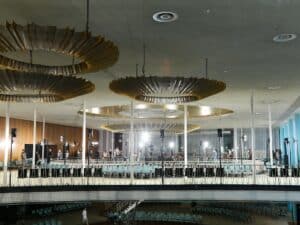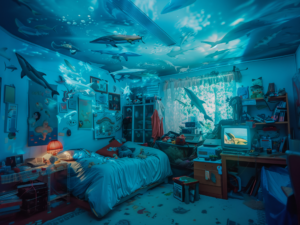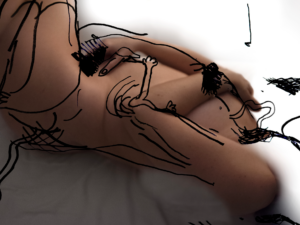How did you discover your fascination with video games and programming?
Thomas Webb: I’ve loved video games since I was a child. I built my first one when I was maybe twelve years old. Later, I went to university to study financial management, and technology became a secondary interest. I taught myself programming after my studies. I’ve always been intensely interested in movies and games, and I’ve completely immersed myself in the stories. I could get lost, especially in the narratives of the games. You make your own decisions, influence the process. What I liked as a teenager was the idea of playing with others – strangers or friends – and exchanging ideas. I think that excellent computer games are captivating and highly communicative.
How did you both develop World Wide Webb?
Anika Meier: From the very beginning, we were interested in showing digital art online. The project started with the planning of a virtual gallery, and from there, Thomas let his imagination run wild. In the end, it became a combination of gallery and computer game, a concept that had never existed before.
TW: The first element I developed was the line at Berghain, where you can queue up in the game. For me, it is a symbol of the freedom and spontaneity of our pre-corona life.
Did you have a concept for the gamer from the beginning?
TW: I had an image for the game’s look, but I didn’t know what story I wanted to tell. My work is very emotional and personal; although I mainly program, it feels more like writing a book. It was a wonderful process watching my visions take shape. At the same time, I was always coming up with new ideas. At some point, I told Anika: “I don’t know how I will ever finish this game.” At that point, she had to be tough with me.
In retrospect, it would probably have been easier to make an exact draft first. Still, it was precisely all the experimenting that made the process strenuous and time-consuming, but also very beautiful.
How long did it take to develop?
TW: The game was created slowly over six months. My work usually is very abstract. Here, suddenly there were speaking characters. It was a significant change from everything I’ve done so far. In the beginning, I was thinking about a thirty-minute game, but at some point, my ideas grew independently and I was adding new elements all the time. The other day, someone told me that he still hadn’t played the game through to the end after five hours. There are so many details to discover.
What was the biggest challenge?
TW: We didn’t know if people would play the game and get involved until the very end. We all have such short attention spans, so it was clear that the game had to be engaging from the beginning to keep people interested. When you spend so much time on a game, the processes and procedures that are logical to you can confuse others. You always have to put yourself in the shoes of someone playing it for the first time.
AM: To come back to the line in front of Berghain… Apparently, some people thought that you could actually get into the club. Since it’s common in computer games to gain access to closed places, maybe not so far-fetched. It never occurred to us. There is an avatar store in the game where you can change. After being rejected, some people went there to try again with a different outfit. Then they would write to me, “How the hell do I get in?”
What fascinates you about video games?
TW: I spent a large part of my teenage years playing Grand Theft Auto and I always thought it was exciting to imagine that you were in the real world and behave that way. The game becomes an extension of my reality.
Profit and loss, euphoria and crashes aren’t far apart in video games.
TW: Video games are like games of chance. When you win, there’s the release of a true dopamine rush. Similar to when you successfully solve a task in a game. You feel a sense of victory. Games are built so that they are addictive, have a real magnetic effect and pull you deeper and deeper into the game. But from what I’ve observed, it’s no longer just about escapism. More than ever, it’s about identifying with the story that is being told, building an emotional bond and empathizing with the game’s character. This can be a kind of therapy and that’s what my game is all about as well.
How would you describe the aesthetics of the game? It’s strongly reminiscent of a Nintendo game from the 80s.
TW: Because of the pixel art graphics I used, everything looks a bit more abstract, and it was possible to really play with colors. I wanted to create this nostalgic atmosphere with the 80s style. The game is only 4MB, which was important to me. After it became clear that typical exhibitions wouldn’t be possible for the foreseeable future, I wanted to create something accessible to everyone.
The game is full of these nostalgic moments, hence the title. What were the references?
TW: I was interested in reviving some sentimental memories from our pasts, something like a karate dojo inspired by the 80s movie Karate Kid. Or a hoverboard.
The future doesn’t reveal itself by setting off into a promising tomorrow, but rather in returning to a nostalgically transfigured yesterday?
TW: Nothing seems impossible in the face of a catastrophe like the one that shook the world this year – and no one saw that coming. Because of this, we’re experiencing an incredible longing for the familiar. A revelation in our own past, so to speak. But, of course, we also miss things, like going to a club or hugging people. Things that have only become nostalgic since March.
Apart from Anika’s help, the development of the game was a one-man show, right? You wrote the concept, programmed everything and also composed the music.
TW: Large teams develop computer games, but I did everything myself. I built a kind of engine for digital art, which was complicated, but it will be much faster if I want to build a new game now. I want to use the medium of video games to further develop the digital art world.
What sound did you want to create for the game and how did you go about it?
TW: I’ve produced music before and therefore roughly knew what to do in technical terms. I edited some songs with Auto Tune to manipulate pitches and slightly alienate and distort voices. I intertwined my singing with artificial sounds. When all six songs were finished, it was fun to think about where I would place them in the game. Fortunately, I have a large network of creative friends and was able to get advice from them multiple times – and show them my manuscripts during the creative process.
Speaking of which, there are live sets by Nic Fanciulli and Mall Grab, Sita Bellan and Kesh perform in the game. Are they friends? How are you connected to them?
TW: These are all friends I told about the project and who wanted to be part of it. Nic is always in Ibiza in spring when the island reawakens and had a lot of time this year. I wanted to create a place for my friends to meet, a bit like a digital party.
Does De School refer to the club in Amsterdam? Do all of the digital locations reference real places?
TW: Exactly, De School is one of my favorite clubs. I miss it a lot, so it had to be in the game. Kanagawa is inspired by my hometown and Osaka is inspired by London, where I live now. Each place shows an important milestone in my life in a different way. I wanted to tell my story. In an abstract way, the game is very biographical.
Does digital art help to democratize the art world because suddenly everyone has access?
TW: World Wide Webb has already been played over 15,000 times. An exhibition in a gallery would never have reached so many people. In recent years, it has become increasingly clear that art and art education can take place digitally. Art no longer has to be understood solely as a physical experience. I think in the current crisis, digitalization helps us continue communicating through art. Of course, this doesn’t always work, the format must depend on the content. I could imagine my next computer game limited to just a hundred accounts. I like the idea of either making art accessible to everyone or creating radical exclusivity. Offline art experiences will always remain interesting despite digitalization.
You can see if someone is more of an extroverted or introverted player, depending on whether and how they communicate with other participants. Do you use the data you collect about the players to improve their gaming experience?
TW: I like the idea that something is tailored to you, your interests and needs. It’s very easy with your data. Therefore, in the background of my game, artificial intelligence analyzes the individual gameplay of the participants and draws conclusions about their characters. In my fantasy, however, data is common knowledge and is only used to optimize our daily life and not for monetization. My focus is on service for the user.
Is the game a political utopia?
TW: Absolutely, I wanted to create a positive place, but at the same time, it also represents our reality. In my data-based virtual world, I want to show that technology can connect people instead of exploiting and alienating them.
Should the big tech companies open their data vaults so that others can also use these treasures?
TW: Sometimes I think about what crazy things we could achieve if we all shared our data freely. But I shouldn’t get lost in this idea because, of course, it will never happen. Internet users must become sovereign digital citizens who control their valuable personal data. It is important to fight for this right. However, we all have to work collectively to achieve this because the balance of power in the digital markets is distorted. On the one side, the corporations with their gigantic data sets, on the other, the individual users.
What is the idea behind the concept, your decision to use the aesthetics of the past to address problems of the future?
TW: It is impossible to think about the future without dealing with the past. I wanted to play with that. Looking back can also help clarify for oneself what the priorities are in the times to come.
What is the future of digital art?
TW: Physical and digital art are still not seen as equal; hopefully, this will change in the next few years. We will be dealing with the question of how to collect digital art. You can’t just hang it up like a picture. As an artist, you have to educate people in a certain way, in their way of thinking, change their perception. The art experience is no longer bound to one place. The audience can feel like curators or even as active co-creators. What seemed to be frozen for a long time is being brought back to life.



